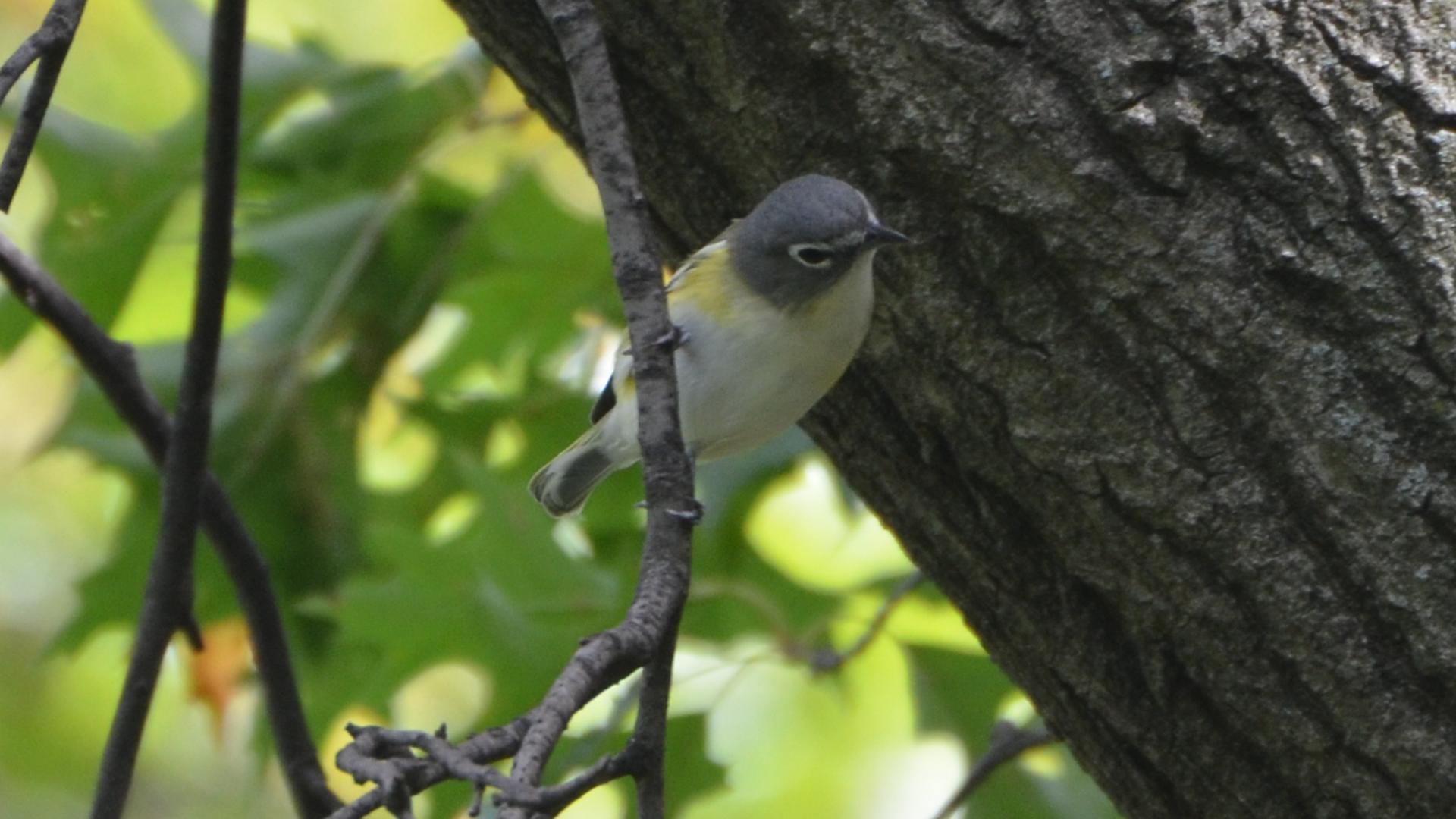Blue-headed Vireo
A species of Vireos Scientific name : Vireo solitarius Genus : Vireos
Blue-headed Vireo, A species of Vireos
Botanical name: Vireo solitarius
Genus: Vireos
Content
Description People often ask General Info
 Photo By Andy Reago & Chrissy McClarren , used under CC-BY-2.0 /Cropped and compressed from original
Photo By Andy Reago & Chrissy McClarren , used under CC-BY-2.0 /Cropped and compressed from original Description
The blue-headed vireo has similar plumage year round and does not drastically change its appearance during the breeding season. It can be characterized by its olive green upper body, two bold yellow wing bars down the edge of its wing, and a deep blue-grey crown from which it gets its name. The juvenile plumage of immature blue-headed vireos is not distinct but very similar to the adult plumage. While this bird's appearance is similar to the closely related Cassin's vireo (Vireo cassinii), the Cassin's vireo can be differentiated by its lighter yellow patches, a smaller, thinner bill, and a brownish-grey crown. There is little to no sexual dimorphism between males and females as both are similar in plumage colouration and size. Like most Vireos, the blue-headed vireo is a relatively small bird with a length of 126–148 mm (5.0–5.8 in). The wingspan is usually found to be around 200–240 mm (7.9–9.4 in) and their weight is typically 13–19 g (0.46–0.67 oz). There are some subtle differences between the V.s. solitarius and V.s. alticola subspecies. V.s. alticola, the larger of the two subspecies, has a darker back with a larger wing length of 76–83.5 mm (2.99–3.29 in) and a bill length of 11–12 mm (0.43–0.47 in). Conversely, V.s. solitarius is slightly smaller with a wing length of 69.2–77.8 mm (2.72–3.06 in), and a bill length of 8.9–11 mm (0.35–0.43 in). The average lifespan of the blue-headed vireo in the wild has been measured to be approximately 7 years and 5 months. 
Size
13 cm
Colors
Brown
Black
Green
Yellow
Gray
White
Life Expectancy
7 years
Nest Placement
Tree
Clutch Size
3 - 5 eggs
Incubation Period
1 brood
Number of Broods
13 - 15 days
Nestling Period
12 - 13 days
Feeding Habits
Blue-headed Vireo primarily consume insects like caterpillars, beetles, and bees, also including butterflies, stinkbugs, wood borers, click beetles, weevils, ants, dragonflies, stoneflies, grasshoppers, and crickets. They hunt insects on live branches and within tree interiors, rarely at branch tips. They supplement their diet with spiders, snails, and fruits from sumac, grape, dogwood, elder, and wax myrtle, particularly during migration and overwintering. With a strong bill and opportunistic feeding behavior, blue-headed Vireo forage in mid-tree levels, adapting to resource availability.
Habitat
Blue-headed Vireo thrive in mature forests with a closed canopy and a developed understory, including deciduous, mixed, and coniferous woodlands. They adapt to forest composition changes and favor regions with hemlocks and evergreens, especially before deciduous trees leaf out. During migration and winter, they inhabit various wooded areas, from suburban parks to tropical cloud forests with dense vegetation.
Nest Behavior
The male blue-headed Vireo selects the site and starts the nest foundation with the female completing it. Nest construction involves both sexes, with egg-laying following. Pair provides parental care for the eggs and the young.
Nest Characteristics
Blue-headed Vireo's nest is typically located 6-15 feet high in a tree branch fork, using materials like bark strips, lichens, grasses, plant fibers, twigs, moss, leaves, fur, and feathers, bound by spiderweb. It measures about 3 inches across, 6.75 inches tall, with an inner diameter of 2 inches and a depth of 1.6 inches.
Dite type
Insectivorous
People often ask
General Info
Feeding Habits
Bird food type
Bird Feeder Type

Small Hopper

Small Tube Feeder

Platform
Sounds
Song
Recording location: United States
Song
Recording location: United States
Behavior
The blue-headed Vireo showcases typical foraging behaviors of large vireos, methodically searching vegetation for insects while remaining often hidden from sight. When forming pairs, blue-headed Vireo exhibits a distinctive courtship display with the male presenting unique postures and vibrant singing. Territorial disputes among males involve countersinging or more intense physical confrontations with threat displays and chases. While females are proactive in territory defense, blue-headed Vireo is not known to be territorial during winter, occasionally singing nonetheless. They adapt by joining mixed-species flocks to forage during migration and winter. Notably, their loud alarm calls contribute to predator mobbing efforts, signaling distress effectively over a distance.
Distribution Area
Native to North America, the blue-headed vireo enjoys a large breeding range that extends over an immense area of Canada and northern United States. The breeding range of V.s. solitarius extends from northeastern British Columbia across Alberta, Saskatchewan, Manitoba, Ontario and Quebec and down to southern Pennsylvania and New Jersey. V.s. alticola has a distinct breeding range that includes western Maryland and south, mainly in the Appalachian Mountains, to northern Georgia. At the end of the breeding season, the blue-headed vireo migrates south to its overwintering area. V.s. solitarius has the longest migration of the two subspecies and inhabits an overwintering area that includes eastern and southern Mexico to northern Central America. V.s. alticola migrates across a shorter distance to an area that extends from southeastern Virginia to Texas. Blue-headed vireos prefer to breed in cool temperate forests, which in the southern part of its breeding range are found at higher elevations. Evergreen forests with spruce, fir, hemlock, and pine mixed with deciduous growth such as alder shrubs, willow shrubs, poplar, birch or maple trees are the habitat of choice. During the winter, blue-headed vireos inhabit mixed woods of pines and hardwoods. They are also found in coastal and flood plain swamps and low shrubby thickets. Year round, even during the breeding season, population density is somewhat low and spread out. Overwintering population densities are usually found to be lower than in the breeding season. The density of the population ultimately depends on the type of forest being inhabited. During migration, blue-headed vireos are often found to flock with groups of different sparrow species but rarely with members of its own species. 
Species Status
Not globally threatened.

 Photo By Andy Reago & Chrissy McClarren , used under CC-BY-2.0 /Cropped and compressed from original
Photo By Andy Reago & Chrissy McClarren , used under CC-BY-2.0 /Cropped and compressed from original Scientific Classification
Phylum
Chordates Class
Birds Order
Perching birds Family
Vireos Genus
Vireos Species
Blue-headed Vireo